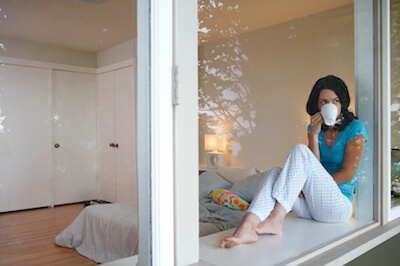If you have allergies, you may face allergy symptoms year-round. And according to the American Academy of Allergy Asthma and Immunology, more than half of the population does.
Cranking up the heat in January can cause more air movement than in the summertime, meaning those dust bunnies can spread into all corners of your home. Tree pollen may peak in the spring and early summer as trees come into full bloom. And as fall’s cool air brings a change in your landscaping, it can trigger all kinds of symptoms once again.
While you can’t change what’s going on outside of your home, you can do your part to control the presence of allergens in your personal space, and improve the air quality overall.
The most common forms of allergens around your home include dust mites, mold and pet dander. Because the environment in our homes changes on a daily basis, its not possible to eliminate allergens, but it is possible to make them easier to clean and maintain.
Cork Flooring
Cork has antimicrobial qualities due to the presence of suberin, a naturally occurring substance that reduces mold, mildew and bacterial growth. Cork flooring provides a hard flooring surface that makes it easy to clean with a mop.
Hardwood Flooring
Hardwood flooring is one of the most beautiful and in demand flooring choices, and with good reason. Hardwood provides a hard surface area that makes it difficult for dust mites to hide, and allows them easily to be cleaned and removed with a simple swish of a mop or vacuum.
Laminate Flooring
Laminate flooring is manufactured by gluing together layers of wood composite. Depending on the manufacturer, these layers can contain dangerous VOCs that can trigger allergies both immediately and over time. Always check the product documentation and talk with a sales representative for the emissions rating before you purchase laminate flooring. If VOCs are low, laminates can be a good choice, much like hardwoods, they are easy to clean and do not harbor dust mites or dander.
Bamboo Flooring
Bamboo offers the same surface qualities as hardwood, yet also offers a water resistant quality that makes it less likely to retain water than traditional hardwood. This reduces both mold and mildew over time. Like laminate, bamboo can be manufactured in a variety of ways, so it’s important to check manufacturing and VOC qualities before installing.
Tile Flooring
Tile flooring is one of the best choices for allergy prevention. It’s easy to care for and easy to spot dust accumulation to clean. When installing, make sure to use low or VOC-free adhesives and keep grout in good repair to avoid moisture from seeping beneath the floor where mold can start to grow.
What’s your favorite flooring type? Have any of these made a difference in your allergy symptoms?
